RNLVAF
at war: The HONAM Conflict
Introduction
Ever since Jeroen "Lawndart" Wedda gathered a group of flight
sim enthusiast for the first time back in 1997 for a LAN meeting, this
group has evolved into a professional hardcore flightsim squadron with
at least four LAN meets a year, (and some smaller ones in between), one
of which is the infamous international Big Bear meet.
Over these years we have continued to develop gameplay scenario's to maximize the fun and realism at these meets. With the venerable Flanker 1.5 a lot of expertise was gained. Its flexible and easy to use mission editor made for excellent on the spot mission design and has never been surpassed in its ease of use. Flanker 2.0 did not fill the gap when Flanker 1.5 became obsolete, and Falcon was still in its early days.
But with the arrival of eFalcon 1.09 we feel we have again reached the high level of immersion from our early days with Flanker 1.5. So in the weekend of 25-27th of May, the fight was on. In our regular Youth Hostel as base of operation we were thrown into the Honam conflict.
Background
story
The south of Korea has three different factions, with the ROK at the north
as a neutral faction. The eastern part of southern Korea has fallen to
retro communist factions with an aggressive state of mind - the DROP -
The Democratic Republic of Punsan. We are hired as mercenaries by the
Honam Republic to help them counter an imminent invasion and protect strategic
oil facilities and a refinery situated on a peninsula of our territory.
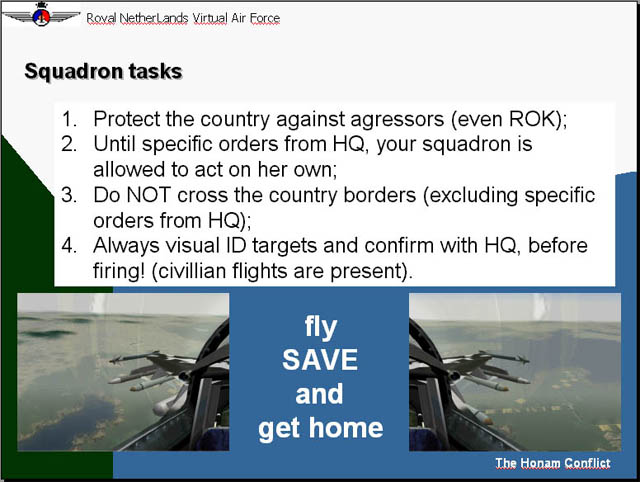
Example of the excellent Powerpoint briefing
(click to enlarge)
Being mercenaries, one of the essential gameplay elements required bringing back the planes, since it would hit hard on our payments not to. In the past, we felt we developed a bit of a respawn culture while flying, and we decided to turn down the bravado factor to enhance realism; better "return to base and fight another day" than "die in the virtual sky" (to quote Dan "Crash" Crenshaw).
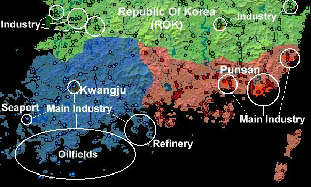
The theatre of operations; Punsan threatening
from the East
Scenario
and gameplay decisions
Two of our RNLVAF game masters, Chera "Napalmski" Bekker and
John "Baco" Menkema developed a huge multihour TE mission (dubbed
a "mini campaign") involving air and ground units from the enemy
following a cunning plan. It took Baco a whopping 34 flight hours of gameplay
to check the progress of this campaign in preparation of the weekend.
Talking about dedication.
Our side had a limited number of planes, helicopters and transport aircraft
and some ground units to do the job. Planning had to be performed on the
fly, as it was decided to make it a turn-based affair.
·
Plan a series of sorties
· Carry them out
· Assess the damage and enemy progress
· Adapt the strategy
· Plan a new series of sorties, etc.
Baco acted as "president" of the government of Honam and also planned al sorties on the fly, since he can work miracles with the editor.
By
carefully hiding enemy forces while projecting the war picture with a
beamer on the wall of the Ops room, all participants could actively involve
in tactical discussions and strategy, guided by Napalmski who acted as
Squadron Commander. From recon missions to SEAD, strike, CAP, it was all
on us to decide.
With an excellent tactical PowerPoint briefing everybody was involved
in the conflict from the start with the background story and the political
picture.
Start of the conflict.
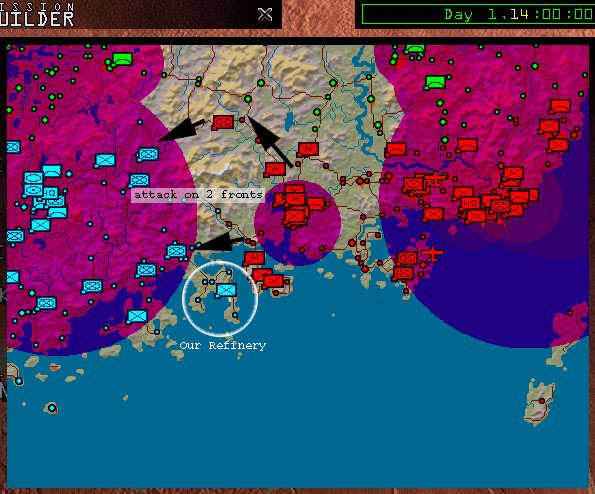
Stage
one of the battle of Honam: the enemy has a cunning plan... 14:00 hours.
The first range of sorties comprised of CAP patrols and some recon missions
in the border area under strict ROE. Everyone got a chance of flexing
his flight muscles (mine had suffered severely from recent additions to
my family, so I finally could ask someone when to switch to Cat III, not
even had the time to read all the excellent 1.09 docs…)
It always strikes me how difficult it is to get the team co-operation
element in place at a LAN meet. Procedures get rusty, Situational Awareness
is awful at first, people get lost.
Fortunately in this mission everything was relatively quiet at the front
although some skirmishes were noted at the border.
Jan "Ghost" Damhof en Gert "Legend" Wijbrans were checking out the border area when they noticed ground troops crossing the border. Ghost was hit, resulting in a flame out, which resulted in some frantic radio traffic on hot start procedures. The engine restarted and Ghost succesfully limped back to base. Great teamwork and cool flying by Ghost, who avoided a crash in tens of metres…
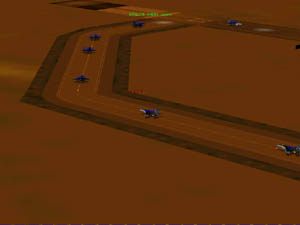
The RNLVAF ready for battle; this is the real stuff;
all sorties were flown by human pilots. (click to enlarge)
During the assessment of this initial mission it was clear that enemy troops were massing at the border for an invasion on two fronts, in the north and in the south of our area. Although everybody felt the need to strike a nearby enemy base to gain air superiority (one of the squadron's favorite mission types) to avoid endless sweeps and CAP flights, careful analysis of the tactical picture led to the decision to take out some vital bridges to stem the enemy ground advance and pinpoint them behind rivers.
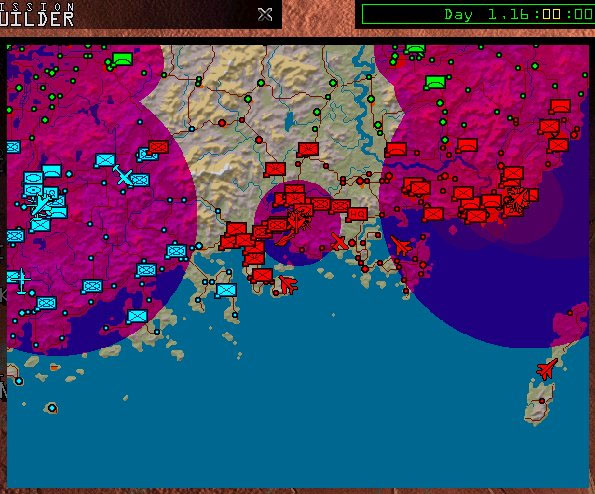
16:00 hours. Enemy units move fast into
our territory; bridges are vital targets
Things
were clearly heating up in the next series of sorties. The bridges in
the north were hit effectively, but in the south one bridge was hit but
not destroyed. The excellence of gameplay preparations showed in the debrief.
Enemy troops had crossed the bridge and were threatening the refinery
on our peninsula. At least three armored battalions and additional infantry
units were progressing rapidly. If only we had hit that bridge…..
Now the situation rapidly deteriorated.
On top of this, enemy choppers that had been spotted during the sortie
(and one or two downed) apparently had been on their return flight, after
having dropped airborne troops in the north at strategic nodes! Fortunately
our boys on the ground up north could deal with this threat for the time
being.
Whenever
things get this ugly there is only one choice. We had to resolve to the
last tactical option available, Combat Air Support while avoiding friendly
fire incidents. Ugh!
It was also decided to fly in our own reinforcements to occupy vital nodes
to avoid a breakthrough, and to bring in our own strategic reserves from
behind the frontline to reinforce our ground troops. So the Chinooks were
sent in, and armored units were retargeted towards the front. But will
they make it in time…
All available pilots were loaded with cluster munitions and off we went.
All enemy units were progressing on a single road into our territory and
soon it was dubbed the "highway of death".
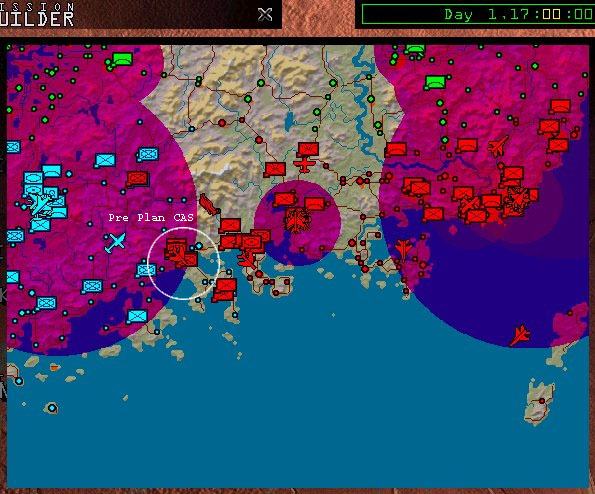
17:00 hours. Things are heating up; go
down and get your hands dirty
We delivered a good punch, with 30+ armored vehicles shredded to pieces and most pilots bringing back their planes, although co-ordination in the attack phase could be improved. Too much ammunition was dropped on the same units. But in a beautiful sunset we returned with a clear sense of achievement. But how have we done, darkness is setting in, how is the threat now? Tension was clearly rising and I personally saw doom & gloom in the upcoming series of events.
The
debrief showed the impact of this series of sorties, but our frontline
ground troops had suffered also and were retreating, while the armored
reinforcements had not yet arrived. The Chinooks also had not dropped
their troops on the battlefield yet, so it was decided to go in again
with the same task to further relieve the pressure on our ground forces.
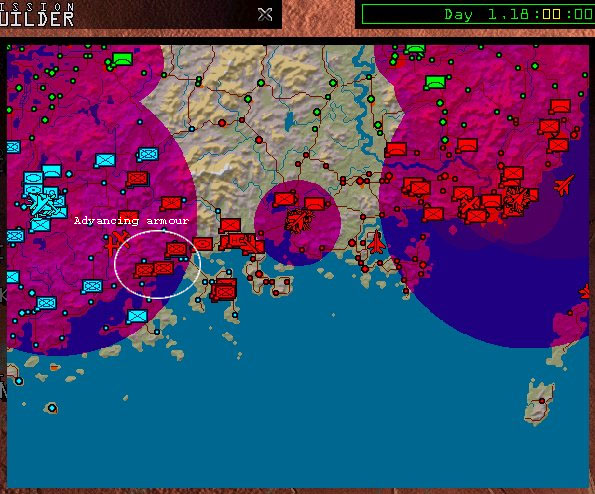
18:00 hours: Another CAS sortie is needed
for a final blow against anemy armour...
In
a darkening sky we went in again, Cat III loaded with cluster ammunitions
and clearer co-ordination to maximize our punch. This sortie surpassed
any flying we had done so far. Planes were swirling in the skies above
the invaded territory, people were calling of shots, intruding enemy fighters
were intercepted. This was clearly one of my most intensive flying experiences
ever. On return this quality flying clearly showed in the results…
The enemy armored columns had been obliterated, and soon we read in the
map screen that DPRK forces had decided to surrender. The invasion was
countered in this decisive strike.
The northern front had been held as well, so we all felt we had earned
our wages as mercenaries!
We than decided to try another LAN play concept, by firing up a regular Falcon campaign and fly it together. But we soon discovered, despite good overall multiplayer stability, that this did not give the satisfaction nor sense of commitment we experienced in our self designed TE mini campaign. The time between flights also proved to generate a lot of waiting without the possibility of speeding things up.
It didn't take long for one of our pilots to suggest we could go in our mini campaign again and deliver a final punch in the Hornet's nest. It being Sunday afternoon, some people had to leave so with a slightly smaller squadron we decided on a nighttime strike in the hart of the enemy capital to "cut the head of the snake". Vital communication relays, pinpoint strike on government buildings and SEAD assistance were the ingredients for this last long-distance "Back to Baghdad" style mission. Mission preparation was critical, up to a point that the strike guys made sketches of their target layout, some of them taping them to their legs for reference. How real can it get? This proved vital in target acquisition of the AAA lit skies of the target city…
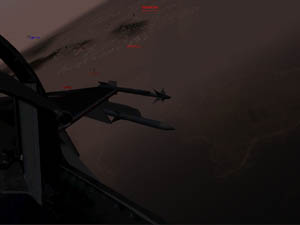
A view from the pit of Ghost,
with Ejecto in the background lining up his LGB's… (click to enlarge)
It
proved to be a blast. All routines were sharp, everybody was completely
familiar again with the co-operative gameplay, and one by one we lined
up in the darkness for the classic CNN images of LGB impacts on downtown
targets. I couldn't get a solid lock on my target (the cursor kept jumping
to nearby ground forces) but my wingmen took over and I saw the impact
of his munitions on my MFD as if I was buddy lasing. Our secondary target
was hit as well.
On the long return flight we were jumped by two Mig-19s, but the response
was efficient and deadly from our side and in no time they were game.
The radio chatter (using CB radios) was just as real as it gets ("snake
2, you are shooter") and I was completely involved and away.
Conclusion
Every LAN meet we ask ourselves when the magic will wear off. We thought
it would end when Flanker 1.5 was fazed out of action. We saw doom when
Falcon was first released with its non-functional network play. But we
are still improving and every LAN meet seems to better than the last.
For the first time in the (short) history of our LAN no single other sim
or game was played collectively other than eFalcon.
All praise to all those dedicated enthusiasts who have carried the Falcon
legacy to this point. The eFalcon 1.09 provided for a very stable online
environment with 10 pilots in the air every time. We decided on using
the -pf 50 switch for the executable, with 56K for the clients and T1
for the server. This proved to be the best solution. Regular rebooting
between sessions seemed sensible as well.
One problem we encountered might be worth mentioning. Everybody in our
squadron who used the Altitude Hold modus of the revised autopilot experienced
strange stalls afterwards in very suspect circumstances. I lost two planes
in a shallow turn at 250/300 knots where the plane would snap into a stall
at exactly 250 knots in Cat I configuration. We all had the distinct feeling
this could be bug in the 1.09 mod. For a moment we thought is was my joystick
calibration, but later tests at home confirmed the stall behaviour after
using the autopilot...
Special thanks must go to our game masters Baco and Napalmski, who have reached a level of magic in gameplay preparations that is unprecedented to our standards. This was a weekend of hard-core flightsimming at its utmost best. Anyone interested in the basic mini campaign files, briefing ppt file, or additional information, feel free to contact me on {redacted} or peek at our club's website at {redacted}.
Willem-Jan
"Ejecto" Renger
CO, Royal Netherlands Virtual Airforce